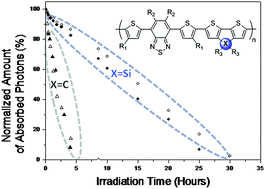Photochemical stability and photovoltaic performance of low-band gap polymers based on dithiophene with different bridging atoms†
Abstract
New low-band gap

* Corresponding authors
a
Risø National Laboratory for Sustainable Energy, Technical University of Denmark, Frederiksborgvej 399, Roskilde, Denmark
E-mail:
manp@risoe.dtu.dk
b Nano-Science Center and Department of Chemistry, University of Copenhagen, Universitetsparken 5, København Ø, Denmark
New low-band gap

 Please wait while we load your content...
Something went wrong. Try again?
Please wait while we load your content...
Something went wrong. Try again?
M. Helgesen, T. J. Sørensen, M. Manceau and F. C. Krebs, Polym. Chem., 2011, 2, 1355 DOI: 10.1039/C1PY00017A
To request permission to reproduce material from this article, please go to the Copyright Clearance Center request page.
If you are an author contributing to an RSC publication, you do not need to request permission provided correct acknowledgement is given.
If you are the author of this article, you do not need to request permission to reproduce figures and diagrams provided correct acknowledgement is given. If you want to reproduce the whole article in a third-party publication (excluding your thesis/dissertation for which permission is not required) please go to the Copyright Clearance Center request page.
Read more about how to correctly acknowledge RSC content.
 Fetching data from CrossRef.
Fetching data from CrossRef.
This may take some time to load.
Loading related content
